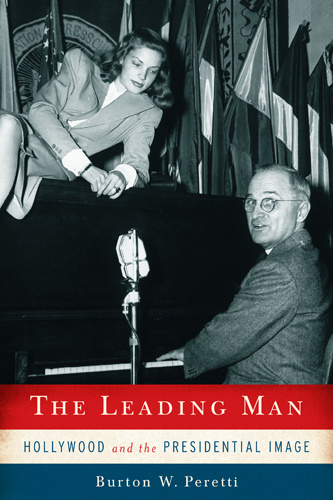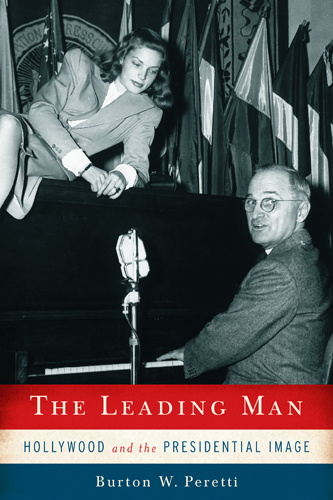
American presidents and Hollywood have interacted since the 1920s. This relationship has made our entertainment more political and our political leadership more aligned with the world of movies and movie stars.
In The Leading Man, Burton W. Peretti explores the development of the cinematic presidential image. He sets the scene in chapter 1 to show us how the chief executive, beginning with George Washington, was positioned to assume the mantle of cultural leading man. As an early star figure in the young republic, the president served as a symbol of national survival and wish fulfillment. The president, as head of government and head of state, had the potential to portray a powerful and charismatic role.
At the center of the story are the fourteen presidents of the cinematic era, from Herbert Hoover to Barack Obama. Since the 1920s, the president, like the lead actor in a movie, has been given the central place on the political stage under the intense glare of the spotlight. Like other American men, future presidents were taught by lead movie actors how to look and behave, what to say, and how to say it. Some, like John F. Kennedy and Richard M. Nixon, took particular care to learn from the grooming, gestures, movements, and vocal inflections of film actors and applied these lessons to their political careers. Ronald Reagan was a professional actor. Bill Clinton, a child of the post–World War II Baby Boom, may have been the biggest movie fan of all presidents. Others, including Lyndon Johnson, showed little interest in movies and their lessons for politicians.
Presidents and other politicians have been criticized for cheapening their offices by hiring image and advertising consultants and staging their public events. Peretti analyzes the evolution and the significance of this interaction to trace the convoluted history of the presidential cinematic image. He demonstrates how movies have been the main force in promoting appearance and drama over the substance of governing, and how Americans’ lives today may be dominated by entertainment at the expense of their engagement as citizens.
Intriguing
A challenging exploration of the intersection between the modern presidency and mass culture, refreshingly free of formulaic celebration and condemnation. This is a book to take seriously.
Peretti’s writing rises above many Hollywood-centered books by viewing the industry from an historian’s perspective. It should appeal to knowledgeable general readers and serious film buffs.
Burton W. Peretti’s The Leading Man deepens our understanding of Hollywood’s increasingly central role in American political culture and reveals the ways in which many twentieth-century presidents adapted Hollywood communication techniques to sell themselves and their policies to voters.
Peretti examines and explains how movie and television screens shaped the image of 14 presidents from Herbert Hoover to Barack Obama. Recommended.
Peretti's analysis provides moments of brilliant insight into the intersection between the film industry and presidential politics.
An insightful study that successfully demonstrates the significance of cinematic culture in presidential politics. Scholars and students of U.S. history and culture will greatly benefit from this volume.
The Leading Man is an intelligent and wide-ranging work that is anchored in impressive scholarship, and it is a terrific read.
Introduction
1. “The Torments of Desire”: Presidents and Performance before 1929
2. The Studios’ Golden Age and the White House, 1929–1945
3. The Old Man and TV, 1945–1960
4. Charisma’s Hour, 1960–1969
5. Enter Stage Right, 1969–1989
6. Hollywood Wags the Dog, 1990–2000
7. The Twin Towers, 2001–2009
Conclusion
Notes
Index




